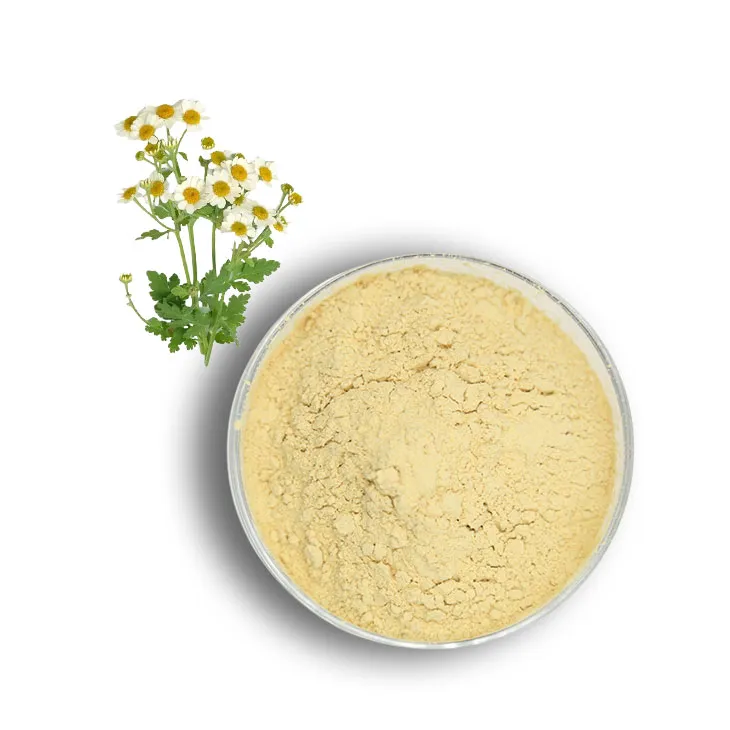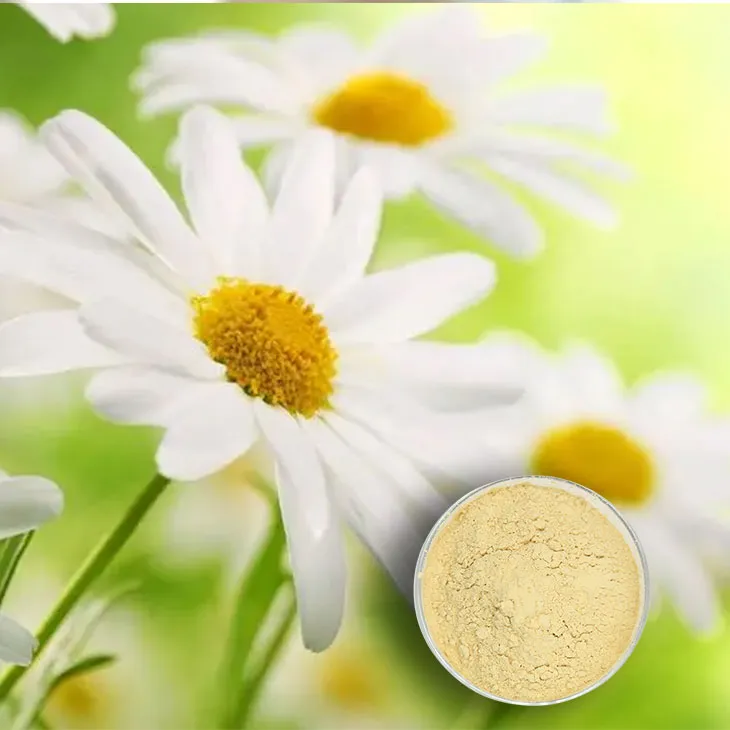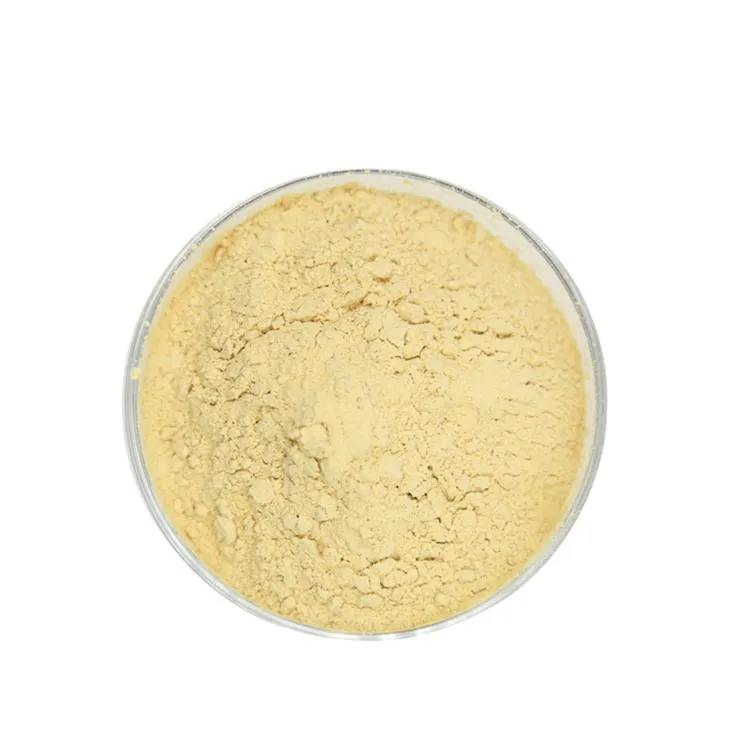- 0086-571-85302990
- sales@greenskybio.com
The Magic of Feverfew Extract Powder: A Comprehensive Guide
2024-11-13

1. Introduction to Feverfew Extract Powder
Feverfew (Tanacetum parthenium) has been known for centuries for its various medicinal properties. Feverfew Extract powder is a concentrated form of the beneficial compounds found in the feverfew plant. It is obtained through a meticulous extraction process that aims to preserve the plant's active ingredients.

2. Chemical Composition
2.1 Sesquiterpene Lactones
One of the key components in Feverfew Extract powder is sesquiterpene lactones. These compounds are believed to be responsible for many of its biological activities. Parthenolide, a major sesquiterpene lactone in feverfew, has been the subject of numerous scientific studies. It has shown potential anti - inflammatory effects by inhibiting certain enzymes and signaling pathways involved in the inflammatory response.2.2 Flavonoids
Feverfew also contains flavonoids such as apigenin and luteolin. Flavonoids are known for their antioxidant properties. They can scavenge free radicals in the body, which are unstable molecules that can cause damage to cells and contribute to various diseases. The presence of flavonoids in feverfew extract powder may enhance its overall health - promoting effects.
3. Anti - Inflammatory Properties
3.1 Mechanisms of Action
As mentioned earlier, parthenolide in feverfew extract powder plays a crucial role in its anti - inflammatory action. It can inhibit the production of pro - inflammatory cytokines, such as interleukin - 1β (IL - 1β) and tumor necrosis factor - α (TNF - α). These cytokines are involved in initiating and maintaining the inflammatory process. By reducing their levels, feverfew extract powder may help to alleviate inflammation in various tissues and organs.3.2 Applications in Inflammatory Conditions
- Arthritis: Inflammatory arthritis, such as rheumatoid arthritis, is characterized by chronic joint inflammation. Some studies suggest that feverfew extract powder may help to reduce joint pain and swelling in arthritis patients. It could potentially be used as an adjunct therapy to conventional anti - inflammatory drugs. - Skin Inflammation: Skin conditions like eczema and psoriasis are associated with inflammation in the skin. The anti - inflammatory properties of feverfew extract powder may be beneficial for soothing irritated skin, reducing redness, and promoting skin healing.
4. Analgesic (Pain - Relieving) Effects
4.1 How It Works
Feverfew extract powder may relieve pain through multiple mechanisms. In addition to its anti - inflammatory action, which can reduce pain associated with inflammation, it may also interact with the body's pain receptors. Some research indicates that it can modulate the activity of neurotransmitters involved in pain perception, such as serotonin.4.2 Use for Headache and Migraine
Historically, feverfew has been used to treat headaches and migraines. While more research is needed to fully understand its effectiveness, some studies have shown promising results. It may be able to reduce the frequency and severity of migraines. Some people report a decrease in migraine symptoms when taking feverfew extract powder regularly.
5. Antioxidant Activity
5.1 Free Radical Scavenging
The flavonoids and other antioxidant compounds in feverfew extract powder are capable of scavenging free radicals. Free radicals are generated during normal metabolic processes as well as in response to environmental factors such as pollution and UV radiation. If left unchecked, they can cause oxidative stress, which is linked to premature aging, cancer, and cardiovascular diseases. By neutralizing free radicals, feverfew extract powder can help to protect the body from oxidative damage.5.2 Protection Against Chronic Diseases
- Cardiovascular Health: Oxidative stress is a major contributor to the development of cardiovascular diseases. By reducing oxidative stress, feverfew extract powder may help to maintain healthy blood vessels, lower blood pressure, and prevent the formation of atherosclerotic plaques. - Cancer Prevention: Although more research is required, the antioxidant properties of feverfew extract powder may play a role in cancer prevention. Free radicals can damage DNA, which can lead to mutations and the development of cancer. By scavenging free radicals, feverfew may help to reduce the risk of DNA damage and subsequent cancer development.
6. Traditional Uses of Feverfew
6.1 Herbal Medicine in Ancient Times
Feverfew has a long history of use in traditional herbal medicine. In ancient Greece, it was used to treat fevers, which is how it got its name. It was also used for various other ailments, including menstrual problems and digestive disorders. Traditional healers believed that feverfew had a balancing effect on the body's humors.6.2 Folklore and Cultural Significance
In some cultures, feverfew was considered a sacred plant. It was often planted near homes to ward off evil spirits and protect the inhabitants from diseases. There are also stories and legends associated with the plant's healing powers, which have been passed down through generations.7. Applications in Skincare
7.1 Anti - Inflammatory and Soothing
As mentioned earlier, feverfew extract powder can be beneficial for skin inflammation. It can be used in skincare products such as creams and lotions to soothe irritated skin, whether it is due to environmental factors like sunburn or skin conditions like acne. It can also help to reduce redness and inflammation associated with skin allergies.7.2 Anti - Aging Properties
The antioxidant activity of feverfew extract powder makes it a potentially valuable ingredient in anti - aging skincare. It can help to combat the signs of aging by reducing oxidative damage to the skin cells. This may result in a reduction in wrinkles, fine lines, and an improvement in skin elasticity.8. Safety and Precautions
8.1 Side Effects
While feverfew extract powder is generally considered safe for most people, some individuals may experience side effects. These can include mouth sores, digestive problems such as nausea and vomiting, and in rare cases, allergic reactions. People with allergies to plants in the Asteraceae family may be more likely to have an allergic reaction to feverfew.8.2 Interactions with Medications
Feverfew extract powder may interact with certain medications. For example, it can increase the risk of bleeding when taken with blood - thinning medications such as warfarin. It is important for individuals taking medications to consult their healthcare provider before using feverfew extract powder.9. Research and Future Directions
9.1 Current Research Findings
Current research on feverfew extract powder is still in progress. However, there have been some promising findings in areas such as anti - inflammation, pain relief, and antioxidant activity. More in - depth studies are needed to fully understand the mechanisms of action and to determine the optimal dosage and formulation for different applications.9.2 Potential Areas for Future Research
- Neuroprotective Effects: Some preliminary studies suggest that feverfew may have neuroprotective properties. Future research could explore its potential in treating neurodegenerative diseases such as Alzheimer's and Parkinson's. - Immunomodulatory Effects: Understanding how feverfew extract powder may modulate the immune system could lead to new applications in autoimmune diseases and immune - related disorders.10. Conclusion
Feverfew extract powder is a natural substance with a wide range of potential benefits. Its anti - inflammatory, analgesic, antioxidant, and other properties make it an interesting compound for further study and potential applications in various fields, including healthcare and skincare. However, more research is needed to fully understand its mechanisms of action and to ensure its safety and effectiveness. As with any natural remedy, it is important to use it with caution and under the guidance of a healthcare professional.
FAQ:
What are the anti - inflammatory mechanisms of white chamomile extract powder?
White chamomile extract powder contains certain bioactive compounds such as flavonoids and terpenoids. These compounds can interact with the body's immune and inflammatory response systems. Flavonoids, for example, can inhibit the production of pro - inflammatory cytokines and enzymes involved in the inflammatory process. Terpenoids may also play a role in modulating the activity of immune cells, thereby reducing inflammation at the cellular level.
How can white chamomile extract powder be used in skincare?
It can be used in various ways in skincare. It can be added to creams, lotions, or masks. Its anti - inflammatory property helps soothe irritated skin, making it suitable for sensitive skin types. It may also have antioxidant effects, which can protect the skin from free - radical damage. Additionally, it can potentially help in reducing redness and promoting a more even skin tone.
What are the traditional uses of white chamomile extract powder?
Traditionally, it has been used for its calming and relaxing properties. It was often made into teas or infusions to relieve stress and anxiety. In some traditional medicine practices, it was also used topically for minor skin irritations and wounds to promote healing.
Are there any side effects of using white chamomile extract powder?
While generally considered safe for most people, some individuals may be allergic to it. Allergic reactions can range from mild skin rashes to more severe respiratory symptoms in rare cases. Also, if used in excessive amounts in skincare products, it may cause skin irritation in some sensitive individuals.
What are the emerging trends in the use of white chamomile extract powder?
One emerging trend is its incorporation into natural and organic beauty products. As consumers are increasingly interested in clean and natural ingredients, white chamomile extract powder is being used more widely in these types of products. Another trend is its use in combination with other natural extracts to enhance its overall efficacy in both skincare and health - related applications.
Related literature
- The Benefits of Chamomile Extract in Skincare" by Journal of Cosmetic Dermatology
- "Anti - Inflammatory Properties of Natural Extracts: Focus on Chamomile" in the Journal of Phytotherapy Research
- "Traditional and Modern Uses of Chamomile Extract" published in Herbal Medicine Journal
- ▶ Hesperidin
- ▶ Citrus Bioflavonoids
- ▶ Plant Extract
- ▶ lycopene
- ▶ Diosmin
- ▶ Grape seed extract
- ▶ Sea buckthorn Juice Powder
- ▶ Fruit Juice Powder
- ▶ Hops Extract
- ▶ Artichoke Extract
- ▶ Mushroom extract
- ▶ Astaxanthin
- ▶ Green Tea Extract
- ▶ Curcumin
- ▶ Horse Chestnut Extract
- ▶ Other Product
- ▶ Boswellia Serrata Extract
- ▶ Resveratrol
- ▶ Marigold Extract
- ▶ Grape Leaf Extract
- ▶ New Product
- ▶ Aminolevulinic acid
- ▶ Cranberry Extract
- ▶ Red Yeast Rice
- ▶ Red Wine Extract
-
Grape Seed Extract
2024-11-13
-
Wheat Germ Extract
2024-11-13
-
Cassia Seed Extract
2024-11-13
-
Yohimbine Bark Extract
2024-11-13
-
Reishi mushroom extract
2024-11-13
-
Curcumin Extract
2024-11-13
-
Camu Camu Extract
2024-11-13
-
Ginger Extract
2024-11-13
-
Sugarcane Extract
2024-11-13
-
Nutmeg Extract
2024-11-13





















